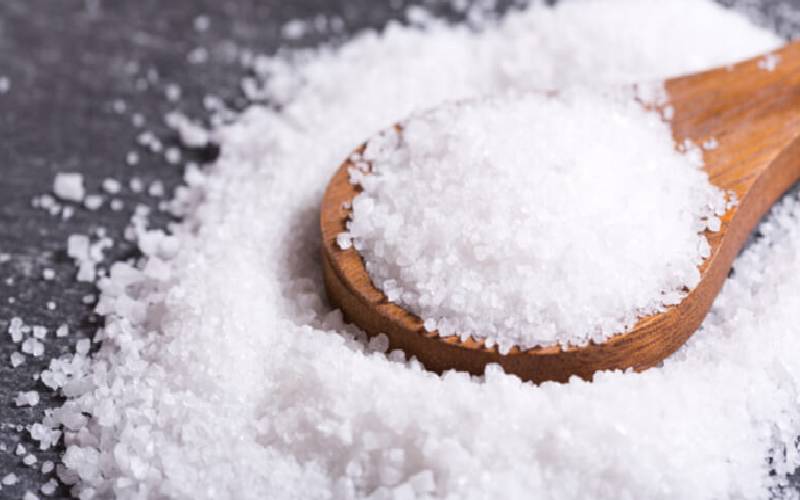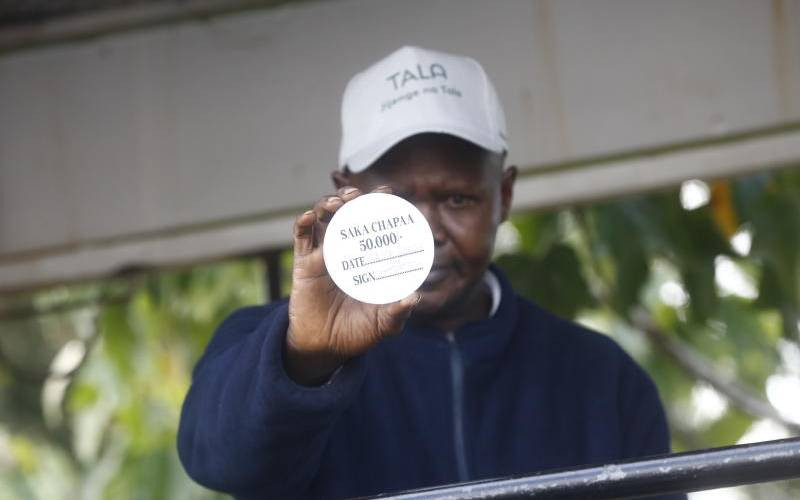 Some of the table salt sold in Kenya is contaminated with tiny plastic particles, which may be a health risk to consumers.
Some of the table salt sold in Kenya is contaminated with tiny plastic particles, which may be a health risk to consumers.
Salt bought from open markets and supermarkets in eight African countries, including Kenya, was tested, and found to contain plastic particles.
“It is obvious that microplastics contamination in table salts should be of a major public health concern,” said Fadare Oluniyi of the University of Chinese Academy of Sciences, and chief investigator in the study.
The researchers collected samples of different brands of commonly consumed commercial table salts from Kenya, Nigeria, Cameroon, Ghana, Malawi, Zimbabwe, South Africa, and Uganda. All the samples, the report in an ahead of the print issue of Marine Pollution Bulletin states, were contaminated with plastic particles, some not visible to the naked eye.
The microplastics can be ingested by marine life, and eventually, find their way into human food. The new study by Oluniyi, Elvis Okoffo and Emmanuel Olasehinde of University of Queensland, Australia and Federal University of Technology, Nigeria, shows this is the first evidence of plastics in local table salt. “This should be cause for worry as it indicates possible contamination of seafood, including fish, with plastics.”
Kenya’s table salt is mainly harvested from the Indian Ocean waters through solar evaporation. Domestically, salt is used for food preparation, seasonings, preservation and even relieving a sore throat. The World Health Organisation recommends that adults consume about 5 grammes of salt per day because it is crucial for balancing body fluids, maintaining healthy blood pressure, and good nerve and muscle function.
How plastics get into salt
Recent studies, the team says, have reported contamination of commercial table salt with plastic particles, but this is the first study to confirm the same in Kenya.
The researchers suggest the salt may be getting contaminated through plastics in seawater or from additives to the salt. “There are possibilities that additives such as synthetic folates or folic acid may be introduced during manufacturing to enhance the final product,” it says.
To support the suggestion, citing the presence of paste-like materials in some of the sampled salts, which can only be rationalised as additives incorporated during production.
However, the research says there was also evidence that the microplastics could be originating from water sources due to high plastic pollution in salt collection sites. “On the basis of our results, the consumption of table salts in Africa represents a major source of microplastics exposure to humans,” said the study.
Seafood a risk too
Human exposure to plastic particles through the consumption of seafood products is currently a source of concern.
In 2018, researchers at the Kenya Marine and Fisheries Research Institute (Kemfri), Pwani University, and Taita Taveta University, presented the first documented evidence of microplastics ingestion by sea organisms in Kenya’s coastal waters.
The team found high microplastics contamination in the ocean, but also evidence it was being consumed by sea organisms called zooplankton. “A total of 129 particles were found ingested by zooplankton groups, as well as fish larvae,” said the study.
Stay informed. Subscribe to our newsletter
Zooplankton are small organisms found in oceans and large water bodies, and provide the primary source of food to marine life and eventually to humans. “Zooplankton are a vital source of food for fish and other kinds of seafood, as such might represent a route via which microplastics enter the food web, posing a risk to other consumers including humans,” said the Kemfri study.
Much of these plastics, the study said, were suspected to have come from major coastal towns of Kilifi, Malindi, Ngomeni and Kipini, and Rivers Sabaki and Tana, which discharge into the ocean.
Last year a team from Embu University also confirmed microplastics pollution in Lake Naivasha, while in June, the abundance of the same was confirmed in Lake Victoria.
Plastics in foetuses
In November, scientists in Italy reported for the first time finding microplastics in the placentas of unborn babies describing this as “a matter of great health concern.”
A dozen plastic particles were found in the placentas from four healthy women who had normal pregnancies and births.
It was suspected the plastic particles had come from packaging, paints, cosmetics or food products.
An advisory of WHO says only microplastics smaller than 20 micrometres (mm) may be able to penetrate human organs. Those within 10 mm may be able to access all organs, cross cell membranes, cross the blood–brain barrier, and enter the placenta.
The sizes of particles that were detected in the Kenya table salt were about 5 mm while those ingested by marine organisms ranged between 0.01 and 1.6 mm making them dangerous if in human foods.
Apart from the possibility of foreign particles causing physical damage to the body, medical experts say the bigger problem posed by the particles is chemical poisoning.
“We now have enough evidence showing plastics contain chemicals that affect the hormonal systems, cause cancers, diabetes, reproductive and neurological disorders in children and foetuses,” said the Endocrine Society in a global report published last year.
Infertile pigs
These chemicals have recently been blamed for the increase of birth defects in male children born in Kiambu County.
They have also been blamed for infertility in male pigs feeding along sewage lines in Nairobi, with scientists seeking more studies to establish the effects the consumption of such meat may have on humans.
The finding of plastic particles in local table salt comes at a time the Ministry of Health is concerned over high consumption of salt, especially among young men.
A study published in 2018 by the Ministry of Health that tracked Kenyans’ consumption of unhealthy foods found men the highest likely to add salt to their food.
Younger men aged 18-29, employed, urban and with higher education are the most likely to add salt to their already salted food.
“This group is the main driver of the now popular nyama-eating culture, also associated with heavy salting,” said Sally Karengi, a consultant nutritionist in Nairobi.
The study had also flagged njugu karanga or groundnuts as among the most highly salted packaged food locally.
But maybe Kenyans are reducing their salt intake. The most recent data shows a decline in salt production, revenues and consumption in the country.
Data from the Kenya National Bureau of Statistics showed revenues in the industry to have dipped to a 36-year low in 2018. Manufacturers fetched Sh19.4 million in revenue from the salt in 2018 – the lowest since 1982.
Production has also been declining over years, with an estimated 86 per cent drop in 2018 from 88,193 tonnes in 1988.
It has also been estimated that as more Kenyans become aware of the health dangers of excessive salt consumption, household use has dropped significantly.
 The Standard Group Plc is a
multi-media organization with investments in media platforms spanning newspaper
print operations, television, radio broadcasting, digital and online services. The
Standard Group is recognized as a leading multi-media house in Kenya with a key
influence in matters of national and international interest.
The Standard Group Plc is a
multi-media organization with investments in media platforms spanning newspaper
print operations, television, radio broadcasting, digital and online services. The
Standard Group is recognized as a leading multi-media house in Kenya with a key
influence in matters of national and international interest.
 The Standard Group Plc is a
multi-media organization with investments in media platforms spanning newspaper
print operations, television, radio broadcasting, digital and online services. The
Standard Group is recognized as a leading multi-media house in Kenya with a key
influence in matters of national and international interest.
The Standard Group Plc is a
multi-media organization with investments in media platforms spanning newspaper
print operations, television, radio broadcasting, digital and online services. The
Standard Group is recognized as a leading multi-media house in Kenya with a key
influence in matters of national and international interest.

 Some of the table salt sold in Kenya is contaminated with tiny plastic particles, which may be a health risk to consumers.
Some of the table salt sold in Kenya is contaminated with tiny plastic particles, which may be a health risk to consumers.




